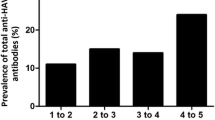Abstract
The aim of the study was to investigate the prevalance of enterically transmitted hepatitis among children living in post-earthquake camps, and to assess the efficacy of the measurements during and after the disaster in Düzce and Golyaka. In the second half of 1999, North-western Turkey, was struck by two massive earthquakes in less than 3months. The first, on 17 August 1999, involving Golyaka, was struck, measuring between 7.4 and 7.8 on the Richter scale. Irregularity about providing clean water and necessary sanitary facilities were observed after the first earthquake because of confusion. The second quake, on 12 November 1999, which rated 7.2 on the Richter scale, shook Düzce. Necessary precautions were applied rapidly at the second quake about shelter, clean drinking water, food and control of distribution of the aids by government and civil aid organisations. Anti-HEV(IgG) and anti-HAV(IgG) antibodies were determined in 476 sera of the children who was living in six camps. HAV prevalence of the children who were living in Düzce and Golyaka temporary houses was 44.4 and 68.8% respectively, OR: 0.37, CI 95%: 0.22–0.61, p=0.0005. HEV prevalence of the children was 4.7 and 17.2% respectively, OR: 0.24, CI 95%: 0.11–0.51, p=0.0007. In conclusion, HAV and HEV prevalence of children were lower than that in endemic areas but higher than that in developed countries. This study has pointed out the importance of providing urgent need of the sufficient sanitary facilities after disasters for preventing or reducing the incidence of enterically transmitted hepatitis, especially in the regions which were at risk for various disasters. Essential precautions such as providing clean water and food supply must be taken and an emergency action plan for preventing the infectious disease must be prepared before disasters such as earthquakes.
Similar content being viewed by others
References
Feinstone SM, Gust ID. Hepatitis A virus. In: Mandell GL, Bennett JE, Dolin R (eds), Principles and practice disease, 5th edn. Philadelphia: Churchill Livingstone, 2000: 920–940.
Trevisan A, Stoco E, Fanelli G, Bicciato F, Paruzzolo P. Seroprevelance of hepatitis A markers in subjects exposed to biological risk. Int Arch Occup Environ Health 1999; 72: 125–127.
Balayan MS. Epidemiology of hepatitis E virus infection. J Viral Hepat 1997; 3: 155–165.
Krawczynski K, Aggarwal R, Kamili S. Hepatitis E. Infect Dis Clin North America 2000; 14; 669–688.
Mateos ML, Camarero C, Lasa E, Teruel JL, Mir N, Baquero F. Hepatitis E Virus: Relevance in blood donors and other risk groups. Vox Sang 1998; 75: 267–269.
Bernal W, Smith HM, Williams R. A community prevalence study of antibodies to hepatitis A and E in inner-city London. J Med Virol 1996; 49: 230–234.
Bissell RA. Delayed-impact infectious disease after a natural disaster. J Emerg Med 1983; 1: 59–66.
Tezcan S. Epidemiyoloji. Hacettepe Halk Sagligi Vak. 92/1, Ankara 1992.
Rees-Gildea P, Eder B. Turkey: Earthquakes. Situation report no. 44, appeal no.19/99. http://www.ifrc.org
Thomas DL, Mahley RW, Badur S, Palaoglu KE, Quinn TC. Epidemiology of hepatitis E virus in Turkey. Lancet 1993; 341: 1561–1562.
Sidal M, Unuvar E, Oguz F, Cihan C, Onel D, Badur S. Age-specific seroepidemiology of hepatitis A, B, and E infections among children in Istanbul, Turkey. Eur J Epidemiol 2001; 17: 141–144.
Aksu K, Kabasakal Y, Sayiner A, et al. Prevelance of Hepatitis A, B, C and E viruses in Behçet's Disease. Rheumatology 1999; 38: 1279–1281.
Montes Martinez I, Agulla Budino A. Prevalence of antibodies against hepatitis A, B, C and E viruses in the rural child population in Northern Extremadura. An Esp Pediatr 1996; 45: 133–136.
Assis SB, Souto FJ, Fontes CJ, Gaspar AM. Prevalence of hepatitis A and E virus infection in school children of an Amazonian municipality in Mato Grosso State. Rev Soc Bras Med Trop 2002; 35: 155–158.
Arif M. Enterically transmitted hepatitis in Saudi Arabia: An epidemiological study. Ann Trop Med Parasitol 1996; 90: 197–201.
Chironna M, Germinario C, Lopalco PL, Carrozzini F, Quarto M. Prevalence of hepatitis virus infections in kosovar refugees. Int J Infect Dis 2001; 5: 209–213.
Santantonio T, Lo Caputo S, Germinario C, et al. Prevalence of hepatitis virus infections in Albanian refugees. Eur J Epidemiol 1993; 9: 537–540.
Author information
Authors and Affiliations
Rights and permissions
About this article
Cite this article
Sencan, I., Sahin, I., Kaya, D. et al. Assessment of HAV and HEV Seroprevalence in Children Living in Post-Earthquake Camps from Düzce, Turkey. Eur J Epidemiol 19, 461–465 (2004). https://doi.org/10.1023/B:EJEP.0000027357.57403.3a
Issue Date:
DOI: https://doi.org/10.1023/B:EJEP.0000027357.57403.3a




